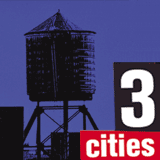
Carved out of the dense fabric of Barcelona's old city sit pockets of open space in development purgatory. Chances are they won't be there for long, thanks to an aggressive municipal campaign to improve public places, and to a corresponding increase in private market pressures. Their futures uncertain, the pockets presently range from fenced-in construction sites to paved lots perfect for a pickup game of futbol. And as for what used to be there, the past is written on the wall.

Although we hear often of city history discovered underground, sometimes urban archeologists look up. Above the ball games of Barcelona, stuck to what had been the neighbors' walls, lie the plaster and tile remnants of families. The wallpaper of bedrooms, the colored tiles of kitchens and the plumbing fixtures of bathrooms all remain, offering the rest of Barcelona a voyeuristic peek into what had been the most personal of domestic decisions. It is a brutal exposing of a family's intimacies. Naked homes, recast as billboards and thrust into the foreground of the public city. One wonders: Who lived against these walls? What meals were prepared and for what celebrations? What dirt was scrubbed clean in those showers; what love was made in those rooms? What lives were lost, and where?
Barcelona is a city with a well-deserved reputation for colors and tiles. Its most famous citizen, the soon-to-be-canonized architect Antoni GaudÔ, defied the modernist disdain for ornament and embraced decoration with such ferocity that it became, for some of his most famous buildings, their raison d'Ætre. A century later, few cities are as predominantly associated with their architecture as Barcelona is today.
Given this context, it's hard not to treat the domestic relics as public installations, although that would be something like calling a well-chosen section of the telephone book poetry. No one planned for these tilings to be beautiful - or planned them at all, for that matter. To admire them merely as urban wallpaper would be to deny their history. And yet, the unintentional artistry captivates us nonetheless.
Building collages capture an essential paradox of the city: they are, in both senses of the word, vital. They are both delightfully so, and necessarily so. They make Barcelona unexpectedly thrilling, especially for the majority of tourists who will return to a less vibrant hometown. But the collages also testify that Barcelona is essentially lived, not visited - it is at heart a collection of people, with specific needs and desires and ambitions and memories and friendships born of circumstance. Should Disney World close tomorrow, the universe would be a few Plutos fewer and so much the wiser. Cities that overly prioritize their culture and entertainment also risk becoming extraordinary to everyone and ordinary (read necessary) to no one. On the other hand, striving to be ordinary is a lackluster goal best left to witness protection programs and suburbs. Striking the balance between the two vitalities, while difficult, has always been what makes jewels of cities, which is why GaudÔ's most valuable gift to Barcelona was not the soaring Sagrada Familia (like most urban monuments, it belongs more to the city's visitors than to its citizens) but rather the example of how a city can modernize while retaining its locality, personality and whimsy.
Topic 3: Cities focuses on this dual charge, featuring a fantastic collection of city watchers and city makers. Our contributors explore plans and protests, garbage and globalization, immigrants and Internets, but beneath each subject lies a fundamental concern - one that I invite you to contemplate yourself: What does it mean, today, to be vital?

Photograph by David Haskell.
Back to Top | Table of Contents | Subscribe to Topic

|

